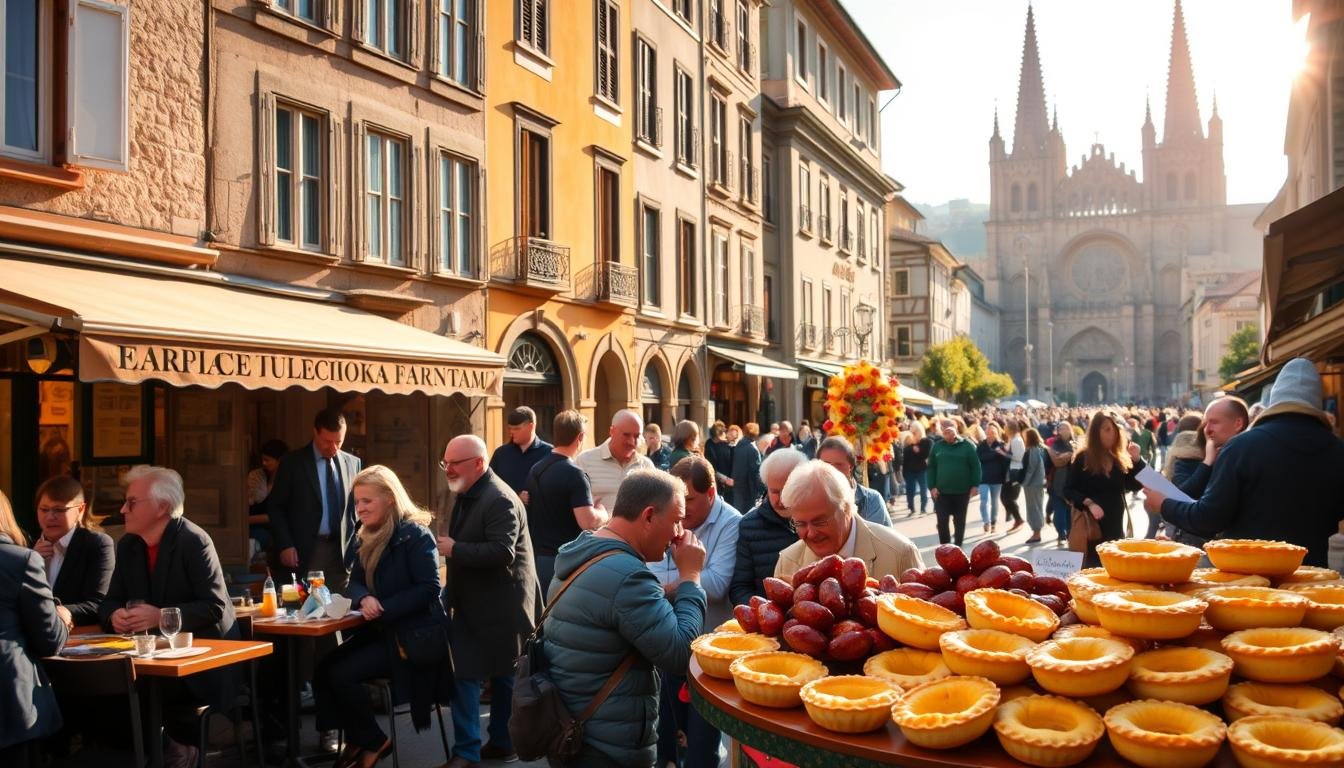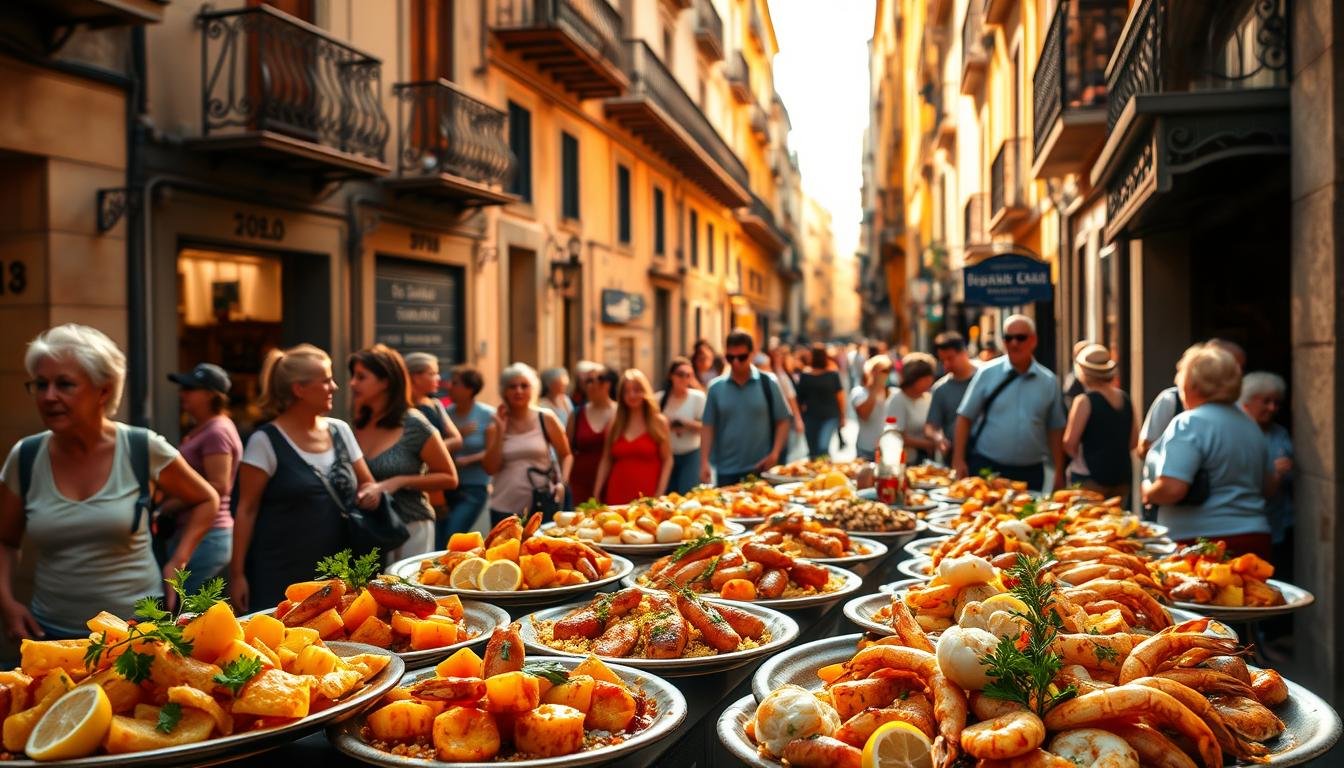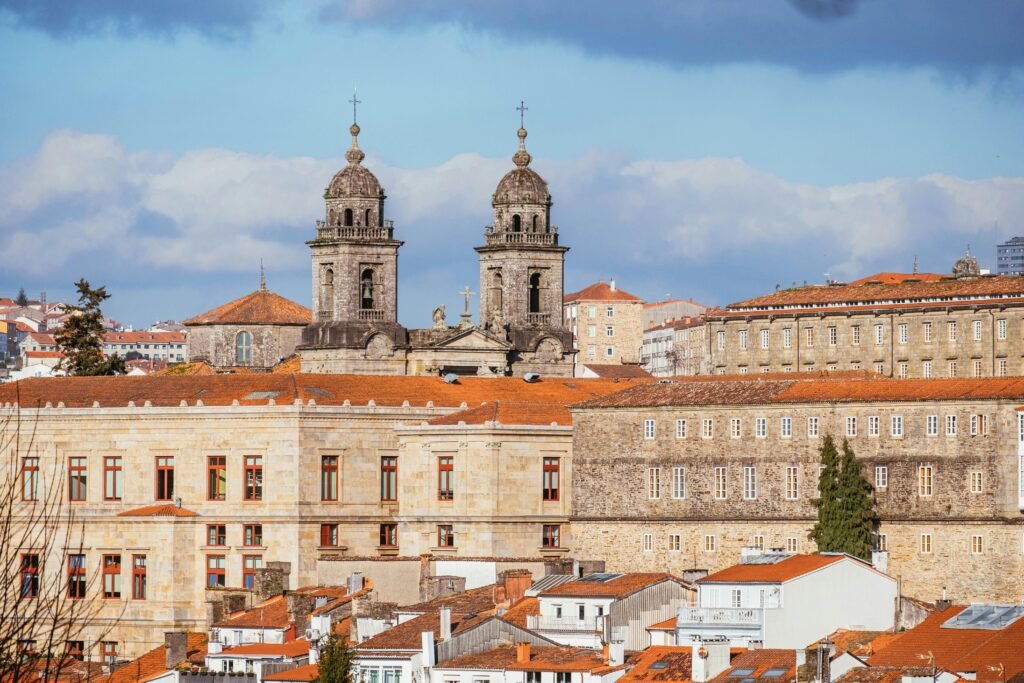
Panoramic view of Santiago de Compostela’s historic architecture under a blue sky.
As you walk through Santiago’s narrow streets, you’ll catch the scent of cinnamon and almonds. Tarta de Santiago, with its powdered sugar, is more than a sweet treat. It opens the door to Galician cuisine.
This city, where pilgrims and food lovers have met for ages, offers a unique culinary journey. It mixes history with vibrant tastes. Every bite tells a story.
Spanish food traditions are alive in Santiago. The sea’s salt air fills empanadas with tuna and onions. Paprika-laced potatoes tempt you at every turn. Exploring Santiago’s markets and family tabernas shows how food tourism thrives in this city.
From the first sip of albariño to the last crumb of almond tart, Santiago’s flavors share stories of resilience and joy. These streets, once walked by medieval pilgrims, now guide modern explorers. They lead to savoring Galicia’s essence, where every dish celebrates the land and sea.
Key Takeaways
- Tarta de Santiago symbolizes the heart of Santiago’s culinary identity.
- Galician cuisine reflects a harmony of oceanic ingredients and rustic techniques.
- Spanish food traditions in Santiago are deeply tied to its role as a historic pilgrimage hub.
- Food tourism Spain reaches its peak in Santiago’s markets and family-run eateries.
- Authenticity here lies in the interplay between ancient recipes and contemporary creativity.
The Gastronomic Soul of Galicia’s Capital
Walking through Santiago’s cobblestone markets, reveals the stories embedded in every ingredient. Galician gastronomy isn’t just about food—it’s a conversation between the past and now. The city’s rich Santiago de Compostela food history, blends ancient Celtic foraging with Roman methods, monastic preservation, and the influence from the Camino de Santiago . This cuisine respects tradition while celebrating the seasons.
Historical Influences on Santiago’s Cuisine
From pulpo a feira to hearty stews, each dish tells a story. The table outlines the key eras:
| Period | Influence | Legacy |
|---|---|---|
| Celtic | Foraged herbs and wild game | Modern use of orelha de freira mushrooms |
| Roman | Trade-introduced staples | Olive oil, wheat, and wine |
| Medieval | Monastic innovation | Preserved fish and almond-based desserts |
The Pilgrimage Effect on Local Food Culture
Pilgrims turned food into a sacred act. Hostels like Obradoiro fed travelers with pote gallego. Today, taverns serve dishes that honor pilgrimage food traditions. “Every spoonful here is a step along the Camino,” says local chef Ana Fernández.
Seasonal Celebrations Through Food
Galician cuisine follows the seasonal calendar. Autumn’s boletus top winter menus;while summer’s San Xoán festival is filled with herb-infused lacón. At Christmas, oyster feasts by the Río Sar, celebrate the sea’s gifts. These celebrations ensure every season is celebrated through food.
Tarta de Santiago: A Sweet Emblem of Compostela
The first view that greets you as you walk the cobblestones, is the authentic Tarta de Santiago near the cathedral. It promises a of a traditional bakery. This traditional Spanish almond cake carries centuries of history in every crumb. Its story is woven into the culinary soul of Compostela.

The Ancient Origins of the Almond Cake
The recipe’s roots go back to medieval monasteries. Monks perfected the Santiago cake recipe using almonds from Andalusian trade routes. The cross of Saint James on each slice is more than decoration—it’s a sacred seal of authenticity.
Bakers today follow this ritual. They blend ground almonds with citrus zest and egg whites in ratios passed down through generations.
Traditional vs. Modern Preparation Methods
At La Pastelería del Apóstol, a master baker hand-knead the dough using techniques unchanged for centuries. Nearby, innovative chefs experiment with sea salt or wildflower honey accents.
Yet, purists say the best Tarta de Santiago in Compostela stays true to its origins. It has no butter, no vanilla—just toasted almonds and patience. For those curious, our adapted version balances tradition with modern kitchen tools.
Where to Find the Most Authentic Versions
Seek out Convento de Santa Clara for cakes stamped with the cathedral’s own molds. For a neighborhood favorite, ask locals about Pastelería San Martín’s melt-in-the-mouth texture. Each bite of these authentic Tarta de Santiago reveals why this almond cake is Compostela’s sweetest ambassador.
A taste of history that feels newly discovered with every visit.
Beyond the Cake: Essential Dishes of Santiago
Galicia’s food goes beyond the famous Tarta de Santiago. Walking Santiago’s streets, you’ll come across dishes that celebrate the land and sea. These dishes tell stories of fishermen and farmers, inviting you to taste the “comida de verdad”—food that’s true.
The empanada gallega is a must-try. It’s a flaky pastry filled with salted cod, tuna, or spinach. At Mercado de Abastos, you’ll witness the use of old techniques to fold dough over fillings. Nearby, caldo gallego warms bowls with its mix of potatoes, greens, and meats. These dishes are more than food; they’re family traditions.
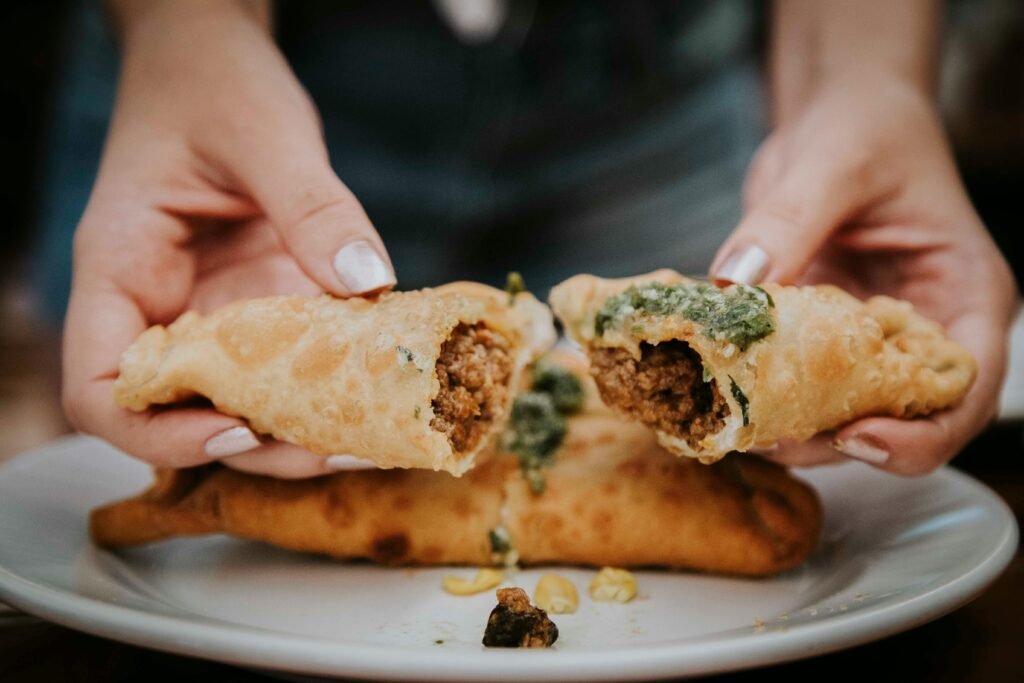
Close-up of a beef empanada being split open, showcasing savory filling.
- Must-try Galician dishes: Lacón con grelos (cured pork with turnip tops), pulpo á feira (charcoal-grilled octopus), and zamburiñas (baby scallops in garlic butter).
- Authentic Spanish regional cuisine is found in family-run tascas. Here, lacón’s tender slices and razor clams from Rías Altas waters are served.
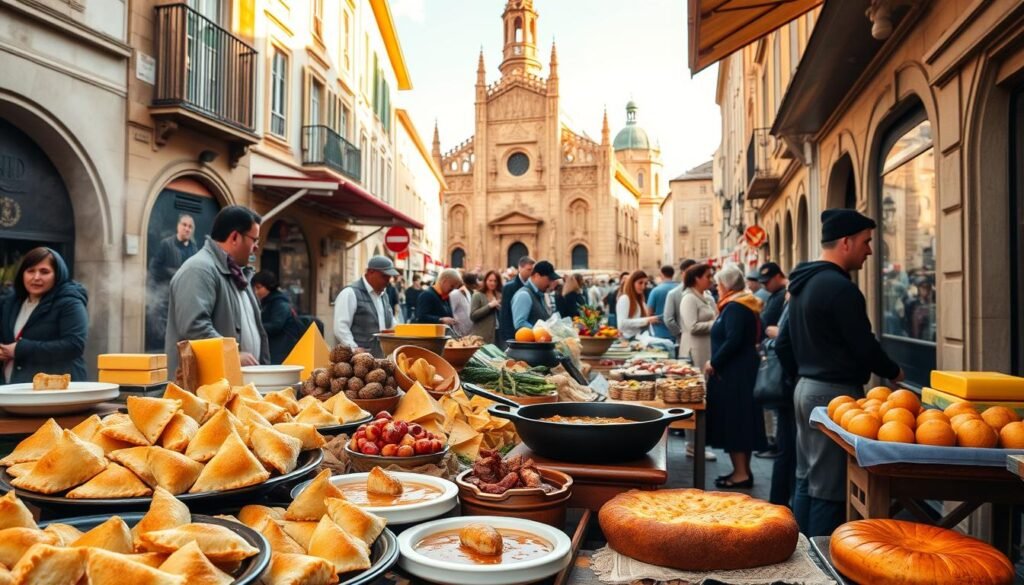
At dusk, the cod fritters (poteiras) and octopus at hidden tascas is a must–try. These dishes are more than recipes; they’re conversations between land and sea. Each bite is a promise to Galicia’s culinary soul, where being true is a way of life.
Culinary Tour of Santiago de Compostela Spain: Routes for Food Lovers
Santiago’s old streets, offer three different routes that make every step a delight. Start near the cathedral, where old traditions meet new flavors. Let’s dive in:
Old Town Tasting Trail
Start at Casa Marco, where they make almond cakes with local flour. Walk down Rúa do Franco to find Casona do Campiño with tasty empanadas. Don’t miss Confitería Lamas for chocolate conchs and churros.
Market-to-Table Experiences
Visit Mercado de Abastos to see fresh seafood and cheeses. Join a workshop to learn how to make pulpo á feira. The market’s energy is amazing when you learn to cook.
Evening Tapas Crawl Options
At night, explore Santiago’s best tapas. Start at La Venencia for a famous potato omelette. Then, go to Taberna O Coto for txokos and albariño. Finish at Tras Torres for smoky octopus. Each place has its own tale of tradition and innovation.
The Seafood Phenomenon: Ocean to Plate
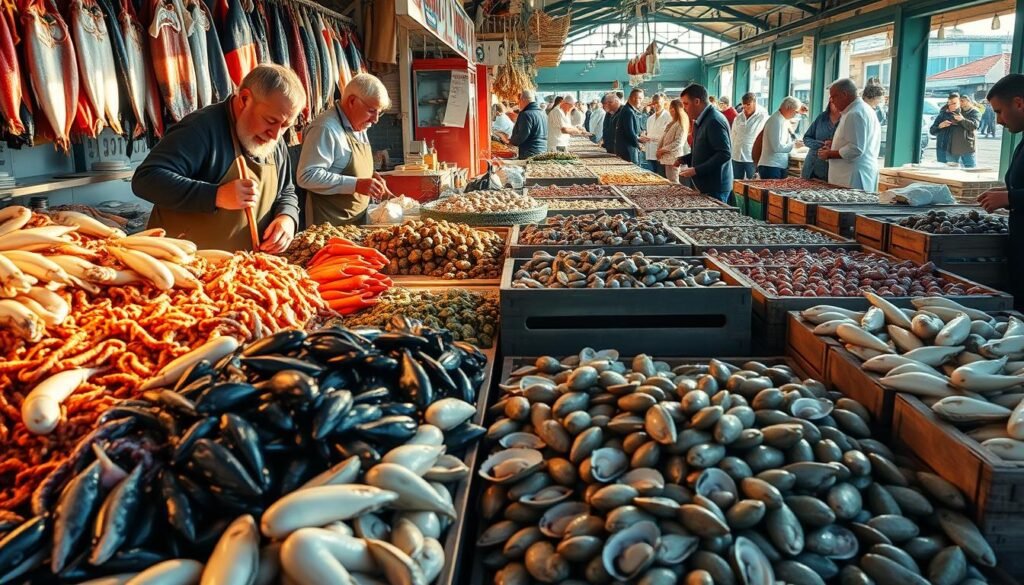
At Santiago’s Mercado de Abastos, you are greeted with the smell of the sea. The air is filled with the scent of fresh seafood. Try the pulpo á feira found at the family-owned counters. Here, chefs turn octopus into art.
They cut the tentacles into perfect circles. This is a tradition passed down through generations. The dish is simple, with olive oil, pimentón, and sea salt. It’s a taste that melts in your mouth, showing the skill of the pulpo á feira recipe.
- Percebes: Prized barnacles clinging to rocky shores, harvested by daring collectors
- Vieiras: Plump scallops, fresh from their shells
- Ameixas: Tiny clams cooked in garlic broth
Spanish seafood is caught sustainably. Restaurants like Casa Marco use arrastre libre methods. This protects the sea and its creatures.
They serve line-caught hake and shellfish from well-cared-for beds. By eating here, you support the sea and enjoy great food.
Every bite of seafood from Santiago de Compostela tells a story. It’s about brave fishermen and chefs keeping traditions alive. This seafood is a mix of adventure and heritage, proving that simple is best.
Wine Pairings: Albariño and Beyond
Exploring Santiago’s streets, you’ll come to discover that Galician wines are as important as its seafood. As you explore the hidden wine bar near the cathedral, the local sommeliers recommend Albariño. Its sharp taste cut through the creaminess of pulpo á feira. The Albariño pairing opens your eyes to how these wines enhance local dishes.
Ribeiro wines amazes you with their floral Godello whites. They pair well with empanadas, thanks to their citrusy flavor. In Ribeira Sacra, Mencía reds from terraced vineyards complemented hearty stews. Each wine shares tales of granite soils and Atlantic winds, showing centuries of winemaking.
Local winemakers say Ribeiro wines are perfect with octopus. Their herbal notes echo the sea. For a deeper dive, Valdeorras bodegas offer vertical tastings of Treixadura blends. These wines are more than drinks; they’re part of the region’s food story.
Sommeliers’ pairing tips showed how Galician wines mix tradition and new ideas. A sip of Albariño’s mineral finish stays with you, like the sound of waves. It reminds us that Santiago’s tastes are tied to its land and sea.
Hidden Gems: Neighborhood Eateries Locals Love
Behind Santiago’s historic streets, a culinary heart beats in authentic Santiago restaurants. Here, old traditions meet new flavors. Locals return weekly, sharing stories of family meals.
As you explore the city, you’ll come across places with sizzling seafood and earthy stews. The air is filled with these delicious smells.
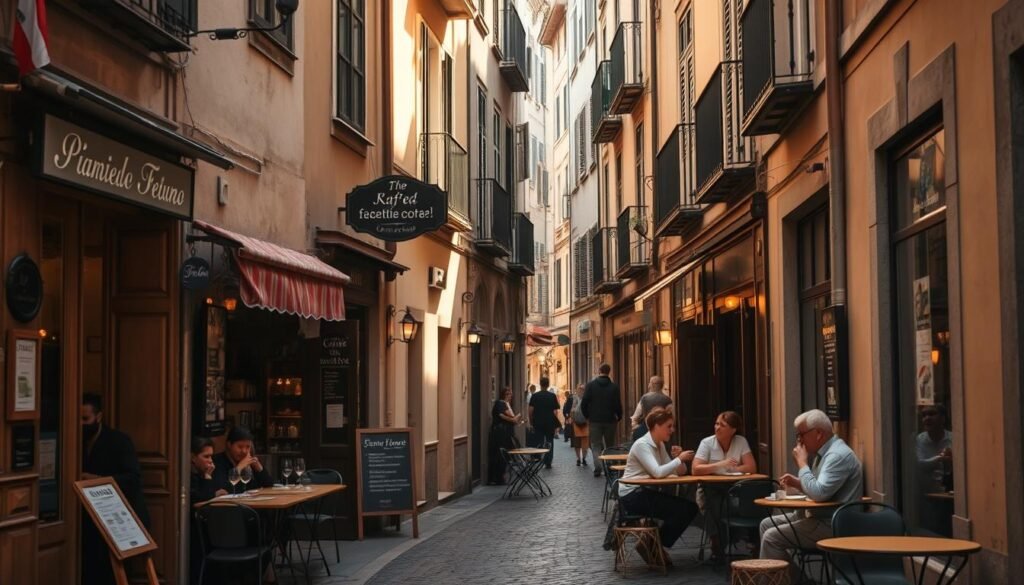
Family-Run Restaurants with Generational Recipes
In Rúa do Franco, Casa Marco shines bright. Abuela Rosa cooks caldo gallego in copper pots. Her hands follow paths set by her mother.
Best Compostela neighborhood restaurants like O Carballo serve polbo á feira. The octopus is so tender, it feels like silk. This recipe has been passed down for three generations.
Contemporary Chefs Reimagining Galician Classics
At A Pedra do Xesto, Chef Ana Soto blends tradition with new ideas. Her empanada de atún has a quinoa crust and pickled onion. It’s a mix of old and new.
“We don’t discard the past; we dialogue with it,” she said. Dishes like cocido gallego with smoked paprika show how traditions evolve.
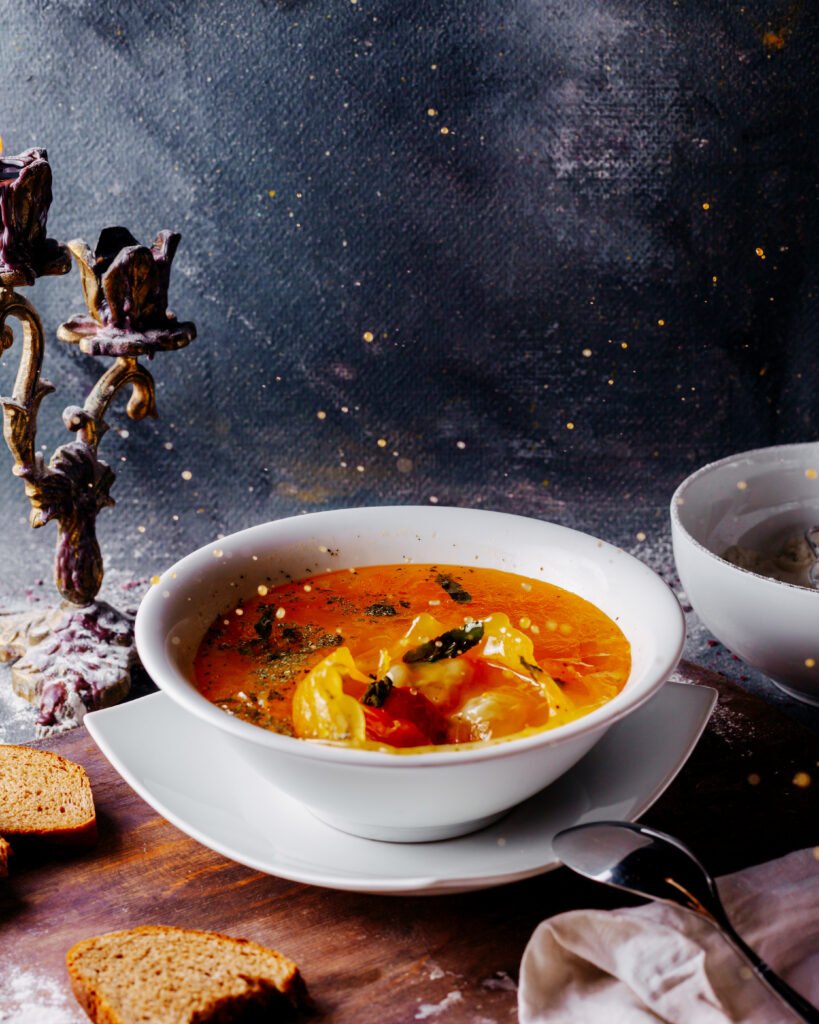
Vegetables soup colored hot with vegetables pieces inside white plate on the bright surface.
Budget-Friendly Finds with Exceptional Quality
At Taberna O Poboado, meals under €15 rival Michelin-starred feasts. Their percebes al ajillo—prawns in garlic butter—shows that affordable quality dining Santiago is real.
At La Merce, workers and students enjoy ensalada de berberechos (goose barnacle salad). It proves Santiago’s best flavors are often hidden in simple places.
The Pilgrimage Connection: How the Camino Shapes Santiago’s Food Scene
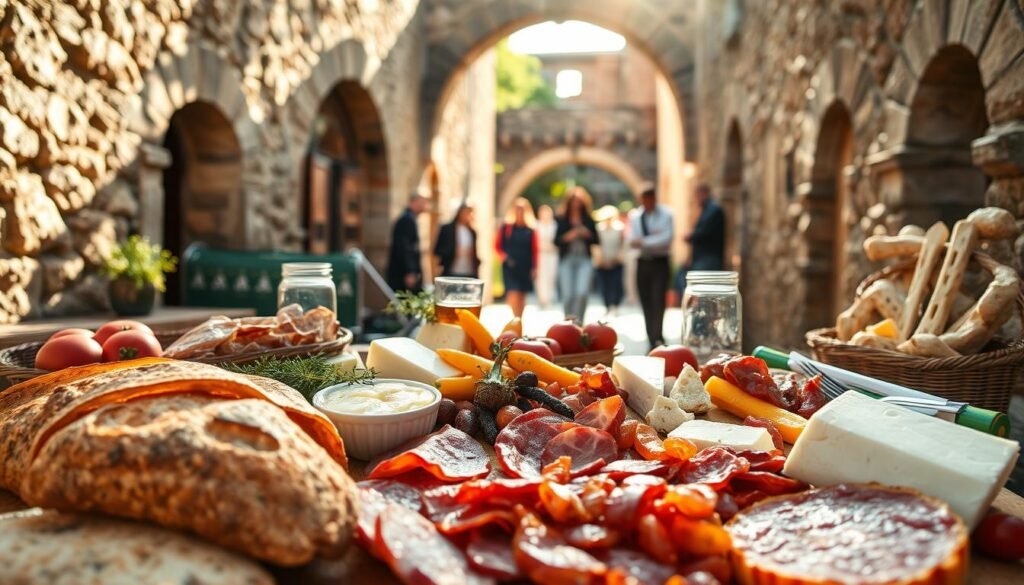
The Camino de Santiago, continue to show how its ancient paths shape Santiago’s food. The pilgrim influence on Galician cuisine is clear in dishes like caldo gallego, a hearty stew for travelers. Today, local eateries offer “menú del peregrino,” blending tradition with new flavors.
At the core of this culinary history Camino is adaptability. Taverns near the cathedral serve empanadas de carne, strong enough for travel. Chefs talk about how pilgrims from around the world added new tastes, like chili-spiced octopus. Yet, they kept the Camino de Santiago food traditions alive.
“The Camino isn’t just stone paths; it’s the taste of shared bread and salt,” said a tavern keeper, shaping churrasco skewers. Her words showed the deep connection between travel and food.
Dining in Santiago follows the Camino’s pace. Lunches are late, like pilgrims arriving at noon. This slow-food way keeps the Camino’s spirit alive, where every meal tells a story of survival and celebration.
Conclusion: Taking the Taste of Compostela Home
As you leave Santiago, the smell of smoked paprika and the sweet taste of Tarta de Santiago stay with you. To keep these flavors alive, visit market stalls full of Santiago de Compostela. Look for vacuum-sealed tetilla cheese, jars of pimentón, and preserved padrón peppers. These items can turn your kitchen into a taste of Galicia.
A family baker in the old town shared their Tarta de Santiago recipe. It’s a mix of almond meal and powdered sugar, passed down through generations. Making it right takes patience, a lesson in Galician cooking at home. It shows how to mix tradition with your own touch.
But Santiago teaches us more than just recipes. It shows us the value of eating with others and respecting the seasons. Sharing a dish of percebes or talking about the best albariño becomes a way to connect. Just like pilgrims have for centuries, bringing a piece of this culture home strengthens our bond with food’s roots. Every bite, whether at a lively pulpería or a quiet meal at home, weaves us into a shared human experience.
